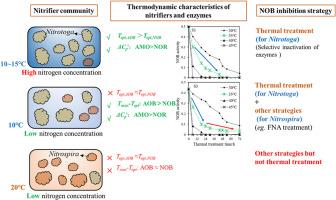硝化细菌的热力学特性揭示了低温下潜在的 NOB 抑制策略
IF 9.7
1区 环境科学与生态学
Q1 ENGINEERING, ENVIRONMENTAL
引用次数: 0
摘要
硝化是一种对温度高度敏感的生物过程,但对污水处理系统中酶催化硝化过程的热力学特性的研究却相对较少。本研究采用了多种热力学模型来评估在不同温度(10、15 和 20°C)和氨氮浓度(40 毫克/升和 300 毫克/升)条件下培养的四种活性污泥样本的热力学特性。结果表明,与亚硝酸盐氧化细菌(NOB)相比,氨氧化细菌(AOB)的最高温度(Tmax)更高,这表明氨氧化细菌具有很强的耐高温能力。相反,NOB 的最低温度(Tmin)较低,表明其对低温的耐受性较强。值得注意的是,低温和高氨氮浓度都有利于硝化甘油菌竞争硝化螺杆菌,导致硝化甘油菌在 10∼15°C 内成为优势 NOB。此外,酶的热容量(ΔCpǂ)在所有样品中表现出相似的趋势,即HAO>AMO>NOR,表明HAO表现出最强的热力学稳定性,其次是AMO,而NOR的热力学稳定性最差。此外,在高氮浓度和低温条件下培养的优势 AOB-亚硝基单胞菌和优势 NOB-亚硝基单胞菌的最适温度(Topt)之差可达 +8.13°C,因此可在 Topt,AOB∼Topt,NOB 条件下通过热处理选择性地灭活 NOR。然而,尽管在低温和低氨氮浓度条件下,Topt,AOB 和 Topt,NOB 的差异不明显,但由于 NOB 的 Tmax 与 Top 之差(Tmax-Topt)较小,且 NOR 的 D 值较小,因此 NOB 比 AOB 更容易受到抑制。然而,由于低丰度硝化螺菌的存在,单靠热处理不足以完全抑制 NOB,必须结合其他策略才能有效抑制 NOB。因此,AOB 和 NOB 在热力学特性上的根本差异决定了低温下 NOB 抑制策略的潜力。本文章由计算机程序翻译,如有差异,请以英文原文为准。

Thermodynamic characteristics of nitrifiers reveal the potential NOB inhibition strategies at low temperatures
Nitrification is a highly temperature-sensitive biological process, yet relatively little research has explored thermodynamic characteristics of enzyme-catalyzed nitrification processes in wastewater treatment systems. In this study, a variety of thermodynamic models were employed to evaluate thermodynamic characteristics of four activated sludge samples cultivated under various temperatures (10, 15, and 20°C) and ammonia nitrogen concentration (40 mg/L and 300 mg/L). Results revealed a higher maximum temperature (Tmax) for ammonia oxidizing bacteria (AOB) compared to nitrite oxidizing bacteria (NOB), suggesting the robust resistance to high temperatures of AOB. Conversely, the lower minimum temperature (Tmin) of NOB indicated its stronger tolerance to low temperatures. Notably, both low temperatures and high-ammonia nitrogen concentrations are conducive to the competition of Nitrotoga over Nitrospira, resulting in Nitrotoga emerging as the dominant NOB within 10∼15°C. Moreover, heat capacity (ΔCpǂ) of enzymes exhibited a similar trend across all samples, i.e. HAO>AMO>NOR, indicating that HAO exhibited the strongest thermodynamic stability, followed by AMO, and NOR has the worst thermodynamic stability. Additionally, the difference in optimal temperature (Topt) between dominant AOB-Nitrosomonas and dominant NOB-Nitrotoga cultivated at high nitrogen concentration and low temperature could reach up to +8.13°C, enabling selective inactivation of NOR through thermal treatment at Topt,AOB∼Topt,NOB. However, despite insignificant differences in Topt,AOB and Topt,NOB under low-temperature and low-ammonia nitrogen concentration, the smaller the difference between Tmax and Top (Tmax-Topt) of NOB and smaller D-value of NOR made NOB more susceptible to inhibition than AOB. However, the presence of low-abundance Nitrospira renders thermal treatment alone inadequate for complete NOB inhibition, combing it with other strategies is necessary for effective inhibition. Therefore, the fundamental differences in thermodynamic characteristics of AOB and NOB determine the potential of NOB inhibition strategies at low temperatures.
求助全文
通过发布文献求助,成功后即可免费获取论文全文。
去求助
来源期刊

Journal of Cleaner Production
环境科学-工程:环境
CiteScore
20.40
自引率
9.00%
发文量
4720
审稿时长
111 days
期刊介绍:
The Journal of Cleaner Production is an international, transdisciplinary journal that addresses and discusses theoretical and practical Cleaner Production, Environmental, and Sustainability issues. It aims to help societies become more sustainable by focusing on the concept of 'Cleaner Production', which aims at preventing waste production and increasing efficiencies in energy, water, resources, and human capital use. The journal serves as a platform for corporations, governments, education institutions, regions, and societies to engage in discussions and research related to Cleaner Production, environmental, and sustainability practices.
 求助内容:
求助内容: 应助结果提醒方式:
应助结果提醒方式:


